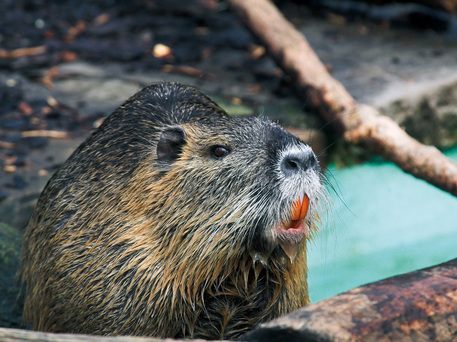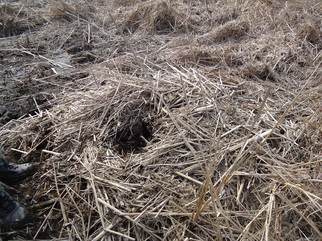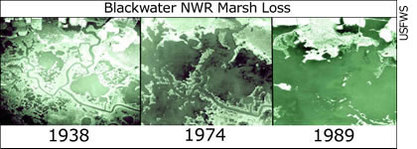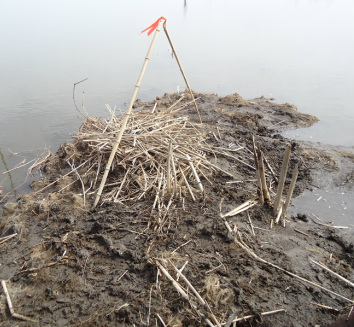The Chesapeake Bay Nutria Eradication Project
The Chesapeake Bay Nutria Eradication Project was formed with a mission to completely eradicate nutria from the Delmarva Peninsula.The project began in 2002, after nutria had caused millions of dollars in damage and destroyed thousands of acres of wetlands during the forty years prior. The goal was not a reduction or controlled level, but the complete eradication of nutria. The project was overseen by a Nutria Management Team of seven specialists from various backgrounds including private organizations as well as the federal and state government. For more about the team, visit the Project Partners page of the website hosted by the U.S. Fish and Wildlife Service. Despite originally aiming to eradicate nutria by 2017, nutria may be fully eradicated by 2015.
|
What are nutria?
Nutria (Myocastor coypu) are semi-aquatic plant eating rodents found in wetlands. Although often compared to the muskrat, they are physically more similar to beavers and only share similarities of their tail with muskrats. Although they average about fifteen pounds, they can weigh up to twenty pounds. For a comparison of nutria to species it is often confused with, visit the U.S. Fish and Wildlife Service page on nutria eradication. How did they get here? Nutria are native to South America but were intentionally brought to North America for their valuable fur. Eventually, this demand disappeared, but due to their lack of predators in the United States, the species did not. They became an invasive species across the U.S., infiltrating twenty two states. |
Nutria's devastating impact is worse because of their population
size. They have virtually no predators in the Chesapeake Bay
watershed beyond the occasional dog or vulture. This lack of
predators allows for unrestricted, exponential population growth. Nutria begin reproducing only six months after they are born. They
can get pregnant less than two days after giving birth, making it
possible for them to give birth to five litters of twelve nutria per
litter in only two years. For a better understanding of how nutria affect each section of the ecosystem, view the nutria food web.
About the project
The team leading the eradication project included Stephen Kendrot of the U.S. Department of Agriculture, who took the time to show us nutria habitats, lodges, and traps throughout the Wicomico River. The Wicomico River and Ellis Bay were the final destinations for the ten field specialists who traveled throughout the watershed setting traps and monitoring nutria. They began this section of the watershed in the spring of 2014, at which time the team expressed confidence that nutria would be eradicated by 2015, two years ahead of the original goal.
The main motivation to start the project came from the intense wetland destruction at Blackwater National Wildlife Refuge. $2.8 million worth of damages were done at Blackwater alone. As nutria consumed and destroyed all the vegetation, the soil washed away and the thriving marsh dwindled into a mucky stream threatening the health of the refuge as well as the Chesapeake Bay. The project goals were not simply to eradicate nutria but also to restore wetlands. By May 2014, over 13,000 nutria had been killed allowing the team to declare over 216,000 acres to be nutria free with only about 10,000 acres to go.
About the project
The team leading the eradication project included Stephen Kendrot of the U.S. Department of Agriculture, who took the time to show us nutria habitats, lodges, and traps throughout the Wicomico River. The Wicomico River and Ellis Bay were the final destinations for the ten field specialists who traveled throughout the watershed setting traps and monitoring nutria. They began this section of the watershed in the spring of 2014, at which time the team expressed confidence that nutria would be eradicated by 2015, two years ahead of the original goal.
The main motivation to start the project came from the intense wetland destruction at Blackwater National Wildlife Refuge. $2.8 million worth of damages were done at Blackwater alone. As nutria consumed and destroyed all the vegetation, the soil washed away and the thriving marsh dwindled into a mucky stream threatening the health of the refuge as well as the Chesapeake Bay. The project goals were not simply to eradicate nutria but also to restore wetlands. By May 2014, over 13,000 nutria had been killed allowing the team to declare over 216,000 acres to be nutria free with only about 10,000 acres to go.
Many people use the words eradication and control interchangeably but Kendrot stressed the differences. Due to their lack of predators and rapid reproduction, control would have been an infinite project. Other areas in the United States, such as Louisiana, have attempted to control nutria with little avail, making it clear that eradication, although far more strenuous and time intensive, is necessary. Eradication requires the capture of every single specimen. "It's a tremendous amount of work," he admitted. "The last ten percent of the population takes ninety percent of the effort." He estimated that at each marsh they captured the first ninety to ninety five percent of nutria during their first week there, but the remaining nutria took three to four more weeks. Kendrot credits their integrated approach as one of the largest contributing factors to the eradication.
How do they know when one river was free of nutria?
Once a nutria was captured and killed, the eye lenses were removed and dehydrated. This indicates the nutrias age which was recorded with its weight, length, sex, and other data. This information allowed for more efficient population estimates and helped to indicate when the project was complete. During the process, different surveys were completed to get more accurate estimates of how many nutria were in each area. Platform surveys, platforms in the water, were set up for nutria to haul-out on. If signs of nutria exist, a trap will be set on the platform. Going through the marsh slowly from a boat allowed them to see the amount of vegetation, muskrat huts, and scat. Land surveys were also common and exposed hauled-out nutria, scat, and tracks. The areas must still be surveyed for several years following the death of the last nutria in order to guarantee eradication. Although the goal will likely be met by 2015, the eradication will not be declared until Kendrot and his team are sure that nutria could not repopulate and infiltrate the Chesapeake Bay watershed. Kendrot modestly explained that the 13,000 nutria caught was not the important number. When dealing with eradication of such a harmful species, what the team leaves behind is the only matter of importance. Because of their diligence, the team will leave behind no nutria, just an unprecedented impact on the Chesapeake Bay's watershed.
How do they know when one river was free of nutria?
Once a nutria was captured and killed, the eye lenses were removed and dehydrated. This indicates the nutrias age which was recorded with its weight, length, sex, and other data. This information allowed for more efficient population estimates and helped to indicate when the project was complete. During the process, different surveys were completed to get more accurate estimates of how many nutria were in each area. Platform surveys, platforms in the water, were set up for nutria to haul-out on. If signs of nutria exist, a trap will be set on the platform. Going through the marsh slowly from a boat allowed them to see the amount of vegetation, muskrat huts, and scat. Land surveys were also common and exposed hauled-out nutria, scat, and tracks. The areas must still be surveyed for several years following the death of the last nutria in order to guarantee eradication. Although the goal will likely be met by 2015, the eradication will not be declared until Kendrot and his team are sure that nutria could not repopulate and infiltrate the Chesapeake Bay watershed. Kendrot modestly explained that the 13,000 nutria caught was not the important number. When dealing with eradication of such a harmful species, what the team leaves behind is the only matter of importance. Because of their diligence, the team will leave behind no nutria, just an unprecedented impact on the Chesapeake Bay's watershed.




